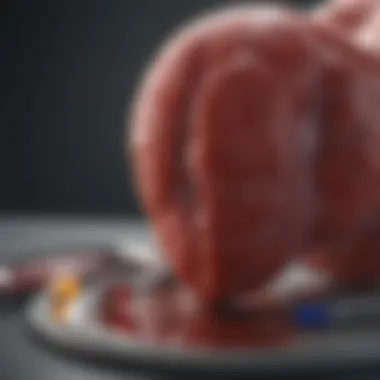High Blood Pressure and Dialysis: A Detailed Analysis


Intro
High blood pressure, also known as hypertension, is a significant public health issue affecting millions globally. Its implications extend beyond the cardiovascular system, deeply influencing renal health. The relationship between high blood pressure and dialysis is particularly crucial, as patients with chronic kidney disease often experience hypertension. This article seeks to unravel the complexities of this relationship, focusing on how hypertension adversely affects renal function and how dialysis is managed in such patients.
The dynamics of hypertension are compounded in individuals requiring dialysis. Understanding the mechanisms at play is essential for educators, health professionals, and researchers alike. This exploration encompasses an in-depth analysis of how high blood pressure interacts with renal health, the consequences for dialysis treatment, and the overall impact on patient outcomes. By synthesizing current findings and treatment modalities, this article offers a comprehensive overview of the interplay between hypertension and dialysis.
Foreword to High Blood Pressure
High blood pressure, or hypertension, is a significant health condition that affects millions globally. Its importance lies not only in its prevalence but also in its potential to lead to severe health consequences, especially in relation to kidney health and dialysis. Understanding hypertension is crucial for improving patient outcomes and informing effective management approaches for those already facing renal difficulties.
Hypertension is often asymptomatic in its early stages, which complicates early detection. Thus, awareness and education regarding this condition are essential for both healthcare providers and patients. This section aims to create a solid foundation for the readers so that they may appreciate the nuances and complexities surrounding hypertension and its implications, especially in patients requiring dialysis.
Definition and Prevalence of Hypertension
Hypertension is defined as a persistent elevation of blood pressure, typically marked by readings above 130/80 mm Hg. It is a common condition, with estimates indicating that nearly 1 in 3 adults in the United States live with hypertension. The increasing prevalence of hypertension is largely attributed to factors such as aging, unhealthy diets, inactivity, and stress. Understanding the prevalence of hypertension is crucial for public health initiatives and for tailoring strategies to mitigate its impact.
Types of Hypertension
Primary Hypertension
Primary Hypertension, also referred to as essential hypertension, comprises about 90-95% of cases. It is characterized by high blood pressure with no identifiable cause, and it typically develops gradually over many years. The key characteristic of primary hypertension is that it often emerges without any apparent underlying health condition. This makes it a popular topic for research and discussion in relation to kidney health.
The unique feature of primary hypertension is its multifactorial nature, influenced by genetic, environmental, and lifestyle factors. Addressing this type involves comprehensive lifestyle modifications. It allows healthcare providers to explore effective, personalized treatment plans that can lead to better health outcomes for patients, especially those on dialysis.
Secondary Hypertension
Secondary Hypertension occurs as a direct result of another medical condition, such as kidney disease, hormonal disorders, or the use of certain medications. The significant aspect of secondary hypertension is its identifiable source; hence, managing it often involves treating the underlying condition. This makes secondary hypertension a critical area of focus for healthcare practitioners, particularly in patients who also face kidney issues.
The unique feature of secondary hypertension is its potentially reversible nature. If the underlying cause is managed effectively, blood pressure can often be restored to normal levels. However, if not addressed, it can lead to more severe complications, especially for those requiring dialysis.
Pathophysiological Mechanisms
To comprehend the full impact of hypertension on health, it is essential to explore the pathophysiological mechanisms at play. High blood pressure can exert excessive force on the arterial walls, leading to structural changes and reduced elasticity of blood vessels. Over time, this increased pressure can damage various organs, including the heart and kidneys.
Renal function, in particular, can be severely compromised by the effects of hypertension, resulting in a condition known as hypertensive nephropathy. This condition can progress, necessitating dialysis or renal replacement therapy. Understanding these mechanisms isn’t just beneficial; it is crucial for developing targeted treatments and management strategies that address both conditions holistically.
Impact of High Blood Pressure on the Body
High blood pressure, or hypertension, plays a significant role in the overall health and functionality of the body. Its effects can be multifaceted, impacting various organs and systems. Understanding the implications of high blood pressure is crucial, especially for those at risk and healthcare professionals involved in their care. This section details how hypertension affects cardiovascular health, renal function, and presents other potential health complications.
Effects on Cardiovascular Health
High blood pressure is a leading risk factor for cardiovascular diseases. It causes increased strain on the heart, which must pump harder against elevated resistance in the arteries. Over time, this can lead to heart conditions such as hypertrophy, heart failure, and arrhythmias. Chronic hypertension may also promote atherosclerosis, a condition where arteries become narrowed by fatty deposits. This increases the risk of heart attacks and other cardiovascular events.
Consequences for Renal Function
The kidneys play a vital role in regulating blood pressure. However, high blood pressure can lead to kidney damage. This creates a cycle: as kidney function declines, blood pressure may further increase, leading to further renal impairment. Damage to renal blood vessels results in reduced blood flow and filtration capability. Ultimately, this can necessitate dialysis as a treatment option.
Other Health Complications
Stroke
Stroke is a serious condition often caused by high blood pressure. It occurs when blood supply to the brain is disrupted, leading to cell death. The relationship between hypertension and stroke is significant because many strokes are preventable with effective management of blood pressure. Recognizing the risk ensures patients and healthcare providers prioritize maintaining a healthy blood pressure.
"Managing hypertension effectively can reduce the risk of recurrent strokes, improving long-term outcomes for patients."


Vision Loss
Vision loss is another serious complication associated with high blood pressure. It can result from hypertensive retinopathy, where blood vessel damage in the retina occurs due to elevated blood pressure. Early detection of hypertension can prevent severe vision issues later. Thus, monitoring eye health is crucial in the holistic management of patients with hypertension.
In summary, the impact of high blood pressure on the body cannot be underestimated. Its effects are extensive, influencing various aspects of health, particularly the cardiovascular system and renal function. Recognizing these consequences allows healthcare providers to strategize effectively, reducing risks and complications for patients.
Understanding Dialysis
Dialysis is a critical medical procedure for individuals suffering from kidney failure or severe renal dysfunction. This section aims to provide a comprehensive understanding of dialysis, exploring its definition, types, and procedural details. Understanding this topic is essential because hypertension, often present in patients with renal issues, significantly influences dialysis outcomes. The interplay between these two conditions can shape treatment approaches and patient health.
Definition and Purpose of Dialysis
Dialysis is a medical process that artificially removes waste products from the blood when the kidneys can no longer perform this function independently. The main purpose of dialysis is to manage the electrolyte balance, control blood pressure, and remove excess fluids, ensuring that the body maintains a stable internal environment. This process can be life-saving, allowing patients to live more comfortably—yet it also carries risks and challenges.
Types of Dialysis
Dialysis comes in several forms, the most notable being hemodialysis and peritoneal dialysis. Each type has distinct characteristics and suitability depending on the patient’s health status and lifestyle choices.
Hemodialysis
Hemodialysis uses an artificial kidney machine to filter blood. Blood is drawn from the body, filtered through the machine, and then returned. One key characteristic of hemodialysis is its effectiveness in rapidly removing toxins and excess fluids. It typically occurs three times a week at specialized clinics or hospitals.
The advantages of hemodialysis include the ability to closely monitor patients during treatment and manage multiple complications. However, this method has disadvantages, such as requiring regular visits to a facility and the risk of infection at catheter sites.
Peritoneal Dialysis
Peritoneal dialysis involves the use of the peritoneum, the lining of the abdominal cavity, as a filtration membrane. A dialysis solution is infused into the abdomen, where it absorbs waste products and excess fluids before being drained out. The key characteristic of peritoneal dialysis is its flexibility, as it can often be done at home and doesn't require frequent clinic visits.
This method’s advantages include more dietary freedom and the ability to maintain more normal daily activities. However, potential disadvantages include the risk of peritonitis or infection in the abdomen.
Procedure and Process
The procedure for both hemodialysis and peritoneal dialysis is straightforward but requires thorough patient preparation. For hemodialysis, the patient must have a vascular access point, typically in the arm. This access allows blood to flow in and out during treatment.
The peritoneal dialysis procedure starts with the surgical placement of a catheter into the abdomen. The patient learns how to manage the process at home, including the connection of bags of dialysate.
Through these processes, both dialysis types aim to bring balance back to the body’s systems while managing the consequences of high blood pressure that often complicates patient care in this context. Understanding how dialysis functions is crucial for improving healthcare strategies for individuals facing hypertension alongside kidney issues.
The Intersection of Hypertension and Dialysis
Understanding the relationship between high blood pressure and dialysis is crucial in healthcare. Patients who undergo dialysis often face numerous health challenges, many of which are influenced by existing hypertension. High blood pressure complicates the treatment of renal diseases. It not only affects the kidneys' functional capacity but also leads to increased morbidity and mortality rates in patients requiring dialysis. This section will delve into specific elements of this intersection, its implications, and the benefits of addressing these issues in a clinical setting.
Hypertension in Dialysis Patients
Many patients undergoing dialysis suffer from hypertension. The prevalence of high blood pressure in this demographic can be attributed to various factors, including fluid overload, medication side effects, and resistant hypertension.
- Fluid Overload: Due to compromised kidney function, patients often retain excess fluid, which increases blood volume and subsequently elevates blood pressure.
- Medication Side Effects: Many of the medications used to manage electrolytes and fluid levels can inadvertently raise blood pressure.
- Resistant Hypertension: Some patients experience hypertension that does not respond well to standard treatment. This adds complexity to their management.
Recognizing the high incidence of hypertension among dialysis patients allows healthcare providers to implement targeted strategies that are essential for improving patient outcomes.
Mechanisms Linking High Blood Pressure and Dialysis Needs
The relationship between hypertension and the need for dialysis is intricate. There are several mechanisms at play here. Primarily, uncontrolled hypertension can lead to kidney damage, directly causing or accelerating the need for dialysis. Some of these mechanisms include:
- Vascular Damage: Elevated blood pressure can result in damage to the small blood vessels in the kidneys, impairing their ability to filter waste.
- Increased Afterload: High blood pressure means the heart has to work harder to pump blood, which can lead to heart complications, influencing renal health.
- Hormonal Influence: The renin-angiotensin-aldosterone system (RAAS) may become overactive, further exacerbating fluid retention and hypertension.


By understanding these mechanisms, clinicians can better anticipate the impact of hypertension on renal function and explore efficient interventions.
Statistics and Data Trends
The statistical data concerning hypertension in dialysis patients is alarming. Various studies indicate that approximately 50-80% of patients on dialysis exhibit hypertension.
"Managing blood pressure in dialysis patients is not merely a recommendation but a necessity to enhance their overall health outcomes."
Recent data shows trends such as:
- Increased incidences of hypertension correlating with rising rates of diabetes, a common precursor to kidney issues.
- Variations in blood pressure control strategies between different dialysis centers, highlighting a systemic issue in consistent patient management.
Monitoring patient data closely is essential for improving therapies and ultimately, patient quality of life. This information is not just academic; it serves a practical purpose in refining treatment protocols.
Management of Hypertension in Dialysis Patients
Managing hypertension in patients undergoing dialysis is essential for improving their health outcomes. High blood pressure can complicate dialysis treatment and affect overall quality of life. It is important for healthcare providers to focus on both pharmacological and non-pharmacological approaches to manage hypertension effectively. With the complexity of these patients' medical needs, understanding the interplay between hypertension and renal function becomes critical.
Pharmacological Interventions
Antihypertensives
Antihypertensives are widely used to manage high blood pressure in dialysis patients. Their primary role is to lower blood pressure to a safer level. Some common classes of antihypertensives include diuretics, ACE inhibitors, and calcium channel blockers. The key characteristic of antihypertensives is that they can be tailored to individual patient needs based on their overall health status and blood pressure readings. This makes them a popular choice in managing hypertension in dialysis patients.
The unique feature of these medications is their ability to address different mechanisms of hypertension. For example, diuretics help reduce fluid overload, which is particularly important for dialysis patients. However, there are disadvantages, such as potential side effects like electrolyte imbalances.
Medication Adjustments
Medication adjustments refer to the need to modify the dosages or types of antihypertensive medications used by dialysis patients. This aspect is critical due to the differences in how these medications are metabolized in patients with kidney issues. Adjustments may be required frequently, depending on the patient's dialysis schedule and fluid intake. The key characteristic of this practice is that it optimizes drug therapy according to individual patient needs.
The unique feature of medication adjustments is that they allow healthcare providers to balance the efficacy of antihypertensive treatment while minimizing risks associated with overmedication. This method can significantly lead to better control of blood pressure and fewer complications, although it may require constant monitoring and communication between patients and providers.
Lifestyle Modifications
Lifestyle modifications play a vital role in the management of hypertension in dialysis patients. Changes in daily habits, including diet and exercise, can lead to significant improvements in blood pressure control. These modifications can not only enhance health outcomes but also promote a sense of empowerment among patients, motivating them to take charge of their health.
Dietary Changes
Dietary changes have a direct impact on hypertension management. A balanced diet that is low in sodium and rich in fruits, vegetables, and whole grains is essential. Reducing salt intake can help lessen fluid retention and lower blood pressure, making it a beneficial choice in this context. The unique feature of dietary adjustments is their role in overall health maintenance. However, it can be challenging for patients to adhere to diet restrictions due to personal preferences and cultural factors.
Exercise Recommendations
Exercise recommendations for dialysis patients are crucial for managing high blood pressure. Regular physical activity can improve cardiovascular health and aid in weight management. Gentle exercises, such as walking or stretching, are often recommended. The key characteristic is that it increases heart efficiency and can enhance the quality of life. However, some patients may find it difficult to integrate exercise into their routine due to fatigue or physical limitations.
"Integrating both pharmacological interventions and lifestyle modifications can lead to significant improvements in managing hypertension among dialysis patients."
Challenges in Managing Hypertension and Dialysis
Managing hypertension in patients undergoing dialysis presents unique challenges that significantly impact health outcomes. Understanding these hurdles is essential for healthcare providers, patients, and caregivers alike. Addressing hypertension effectively can reduce complications associated with renal failure and enhance the quality of life for these patients.
One major challenge is the adherence to medication and treatment plans. Many dialysis patients also manage other chronic conditions, which may complicate their medication regimens. Noncompliance can arise from factors such as medication side effects, misunderstanding of treatment importance, and the overall burden of managing multiple health issues. Patients may have busy schedules or cognitive difficulties, making it harder to remember to take medications consistently.
"Compliance is often lower among patients with multiple health conditions, leading to a cycle of worsening health complications."
Identifying compliance issues requires a nuanced understanding of each patient’s lifestyle and challenges. Engaging patients in their treatment plans is crucial. Education about the importance of antihypertensive medications can improve adherence.


Compliance Issues
Compliance issues further exacerbate the health problems faced by dialysis patients. This group often contends with varying degrees of health literacy, which can affect their ability to follow through on medical advice.
- Complex Medication Regimen: Dialysis often requires the intake of multiple medications, making it difficult for patients to remember all dosages.
- Cognitive Impairments: Many patients face cognitive challenges due to their medical conditions, which can hinder their ability to follow treatment protocols.
- Psychosocial Factors: Depression and anxiety are common, contributing to a lack of motivation to adhere to treatment plans.
To tackle these compliance issues, healthcare providers may consider simplifying medication regimens, utilizing reminders, and fostering open communication with patients. Utilizing tools such as pill organizers or apps to remind patients can be beneficial.
Fluid Management
Fluid management is another significant challenge for patients on dialysis. High blood pressure is often aggravated by fluid overload, making careful management critical in these patients.
The kidneys play a central role in regulating fluid balance. When the kidneys fail, as in the case of patients needing dialysis, excess fluid can accumulate in the body, leading to hypertension and heart complications. Therefore, careful monitoring of fluid intake becomes essential.
- Fluid Intake Restrictions: Patients may need to limit their fluid intake based on their dialysis schedule. This can be tough, especially if they have a strong thirst due to dry mouth or other conditions.
- Monitoring Weight and Symptoms: Regular weight checks between dialysis sessions can help monitor fluid status. Sudden weight changes may indicate an excess fluid buildup.
- Dietary Considerations: Certain foods can exacerbate fluid retention, and patients should be educated about dietary restrictions. Maintaining a low-sodium diet is often essential in managing high blood pressure.
Managing these aspects effectively can contribute to better blood pressure control and overall health outcomes.
Future Directions in Research
Research continues to be vital in understanding the nexus between high blood pressure and dialysis. There are several avenues for inquiry that promise to enhance patient outcomes and refine treatment protocols. These future directions can be categorized into three main areas: innovations in dialysis technology, exploration of new therapeutics for hypertension, and holistic approaches to patient care. Each of these areas offers unique insights, addressing the complexity of managing hypertension in patients requiring dialysis.
Innovations in Dialysis Technology
Technological advancements in dialysis are crucial for improving efficiency and patient comfort. Innovations such as wearable dialysis devices and portable dialysis machines are being developed to provide flexibility and enhance patient autonomy. Currently, traditional hemodialysis requires patients to visit clinics several times a week, which can lead to significant lifestyle disruptions.
With wearable technology, patients could potentially engage in treatment sessions at home. This method offers convenience and reduces the burden on healthcare facilities. Furthermore, more efficient dialyzers are being produced, which can better remove toxins and excess fluids, ultimately helping to control blood pressure effectively. Researchers are also looking into biofeedback systems that help monitor blood pressure in real-time during dialysis.
Exploring New Therapeutics for Hypertension
New medications targeting the mechanisms of hypertension are in focus. Research on drugs that act on the renin-angiotensin system shows promise. These medications can help maintain better blood pressure control in patients undergoing dialysis. One key development is the exploration of angiotensin receptor-neprilysin inhibitors, which could provide dual benefits by not only lowering blood pressure but also offering protection to renal function.
Moreover, studies are looking at the role of mineralocorticoid receptor antagonists in treating hypertension among dialysis patients. These agents can improve cardiovascular outcomes and reduce the risk of heart disease, a common comorbidity in this population. Research into combining various pharmacological approaches may yield new treatment protocols that are safer and more effective.
Holistic Approaches to Patient Care
The integration of a holistic approach in patient care is becoming increasingly recognized. This strategy focuses on treating the patient rather than just the disease. Effective management of hypertension in dialysis patients involves addressing psychological, social, and lifestyle factors alongside medical treatment. Researchers are investigating how factors such as stress management, nutrition, and community support can influence blood pressure control and overall well-being.
- Mindfulness and stress reduction techniques are showing benefits in controlling hypertension. Regular exercise becomes even more pertinent as part of a comprehensive care plan.
- Nutritional studies are examining specialized diets that help lower blood pressure without compromising renal health, such as the DASH diet, rich in fruits and vegetables and low in sodium.
By promoting a teamwork approach to care, where nephrologists, dieticians, and mental health professionals collaborate, there is potential to improve adherence to treatment plans and enhance patients’ quality of life.
"The future lies in understanding the patients beyond their medical needs, integrating their emotional and social contexts into treatment strategies."
In summary, the future of managing high blood pressure in dialysis patients hinges on innovation in treatment modalities and a broader understanding of patient care. Emphasizing the importance of research in these domains is crucial for developing more effective, patient-centered management strategies.
Ending
The interplay between high blood pressure and dialysis represents a critical area of focus within renal healthcare. Understanding this relationship is pivotal, as it informs both treatment decisions and patient management strategies. As hypertension often exacerbates kidney problems, clinicians must grasp its implications for dialysis patients. This fosters not only better health outcomes but also improved quality of life for those affected.
Summary of Key Insights
High blood pressure is a major contributor to kidney disease, which often leads to the need for dialysis. Key insights include:
- Hypertension's Role: It significantly increases the risk of renal impairment.
- Dialysis Dynamics: Dialysis patients frequently face challenges with blood pressure management.
- Therapeutic Approaches: A combination of pharmacological and lifestyle interventions is essential for better control of hypertension in these patients.
In summary, these elements underscore the complexity of treating hypertension in individuals requiring dialysis. Recognizing the correlation allows for tailored therapeutic strategies and better patient outcomes.
Implications for Healthcare Providers
Healthcare providers play a vital role in managing hypertension among dialysis patients. The implications of this management involve:
- Individualized Care: Providers must assess each patient's specific needs and adapt treatment plans accordingly.
- Education and Support: Educating patients on lifestyle changes such as dietary modifications is crucial for effective blood pressure control.
- Monitoring and Adjustment: Continuous monitoring of blood pressure and kidney function ensures timely adjustments to treatment, improving overall health.



